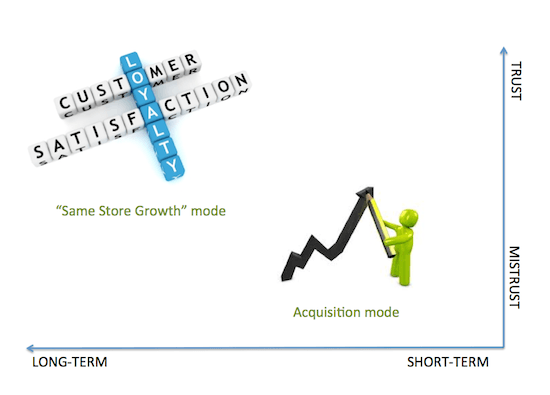2014 is likely going to be remarkable less for introducing major innovations, and more for the new uses of existing technologies. The key differentiator will be in the mindset: are you for or against what is going on? It seems that we human beings like to put thing into opposition: it’s either this or that, either for or against. When it comes to the Internet, few people would argue that it provides no value. Yet, there are many aspects that create concern and anxiety, such as hackers, anonymity, security breaches, invasions of privacy, widespread nonsense, infobesity… If you pile up all the negatives, a case can be made for avoiding the Internet altogether and trying not to leave any trace. To each pairing below, there is a fundamental question that can be asked on a personal and professional level. How you answer to each will have a bearing on your viewpoint about the opportunities, especially in the digital marketing space.
For or Against : Privacy v Security
Are you more concerned with your own privacy or security. The underlying assumption about security is that the powers that be (i.e. ‘government’) are capable of using inquisitive, if not invasive, techniques to detect and delete terrorist activity. The counterpart to this security is giving up some liberties with regard to privacy. Just how far along the spectrum are you willing to allow the government to invade your own privacy to thwart terrorist (or other criminal) activities to ensure our greater security? This is a fundamentally personal question. But, the brand’s value system [including those of the CEO] will need to interface with a customer base that has a more or less greater sense of insecurity and/or an ever greater need for privacy. Brands can garner greater trust by understanding better the customer journey (via empathy) and, for example, by having bona fide opt-in policies and easy opt-outs. Communications that are invasive or interrupting, by definition, break down any sense of privacy. How brands handle customer privacy will be important for crafting the long-term customer value.
Professional v Personal
In certain cultures, there is a major divide between professional and personal affairs. For those who believe in keeping personal and professional separate, the concept is that personal matters and emotions have no role or benefit in business. However, being 100% professional and dedicated to shareholder value tends to make the customer — and employee — wary, if not weary. Mistrust is a major (and well documented) issue for business and brands. Business executives (in the eyes of employees) and brand marketers (for customers) are both at the bottom of the table in terms of trustworthiness. Regaining trust involves renewing listening skills, improving empathy and being more real, aka personal. As such, the frontier between personal and professional is harder to segregate. It is my conviction that leaders and brands need to be more personal. To be clear, I do not mean total transparency (or showing of dirty underwear). However, your personal values and your full body need to be brought to work to make for fully engaged leaders and employees. And, for customers, they expect a real response in real-time and, ideally, from a real person. Business executives can no longer hide their personalities behind the veil of a grey suit.
Confidential v Open
Each enterprise has some tightly guarded secrets. Those secrets, be they product formulas or future plans, need to be kept intelligently under wraps. Just like most normal human beings, there are some things that should not be in the public domain. It’s the difference between intimate and personal. For business, the challenge is finding the balance between keeping secret the necessary information and allowing for enough openness to encourage collaboration and to fluidify communications. Some companies are so secretive that having guests enter is harder than at Langley, Virginia. Employees can feel enrolled in a form of prison. Every item that can record data is taped up. Every conversation may be intercepted. In such locations, wifi is rarely allowed. These are not convivial working conditions. The opportunity to tap into crowd-sourcing and external collaboration, that can be very rewarding and powerful, will typically be missed out. At the very least, communications must be able to move in real-time which inherently means flattening hierarchies and loosening the strings. Inevitably, there will be some errors; but, well-managed, that’s a pallatable risk. The real need for companies is to identify with great rigor just how much information is truly confidential/secretive and enable a freer and more open communication around the rest. This is, without doubt, a strategic question.
Short-term v Long-term
Especially for publicly traded companies — but also for those with private equity houses breathing down management’s back — there is a continuous pressure for immediate results. Even a start-up needs to get near-term results. However, it is all about equilibrium. A similar pendulum swing happens between acquisition and loyalty. You need to find new customers to begin a business. As old customers leave or die out, new customers need to be brought on board. The need is to find a balance between acquiring new customers and knowing how to maintain them over the long-term. It’s the classic battle between long-term health and short-term survival. The best indicator of a healthy business is in same-store sales (or like for like). At the customer level, it is repeat business. Satisfied customers will not just keeping back, they will spread the word. If building a business on the web is no different from building a business offline, the opportunity for stronger word of mouth thanks to the social media outlets has made the pendulum swing more in favor of encouraging fidelity versus acquiring new customers. If you find too many customers leaving, then the real issue may be one of product. For this, acquisition is not the right answer. It’s about having the right and, hopefully, best product. Listening to one’s customer base is one of the key ingredients to product development. The only problem is that listening takes time that can be so rare in a hard-pressed, boiler cooker environment. My conviction: overindex in creating a great product and fostering your existing customer base.
Big Brother or Big Data
This is probably the most crucial axe for business in 2014. With the darkening backdrop of the Target and Neiman Marcus hacking attacks involving over 110 million potentially compromised credit cards, the Lloyds UK hit this past weekend, as well as the 10+ million accounts hit in a devastating breach in Korea (at three major credit card companies), data security may have to be the first port of call. CRM activity is nothing without data. Customers will be loath to provide data under two conditions: the data is not secure or the data will be misused by the brand. A brand’s ability to capture and parse data from multiple datapoints into intelligible files that can be used to create effective and valuable customized communications is the Valhalla of true CRM. In short, it is less about big data, than smart data. With increasing alarm about data security and hints of Big Brother, customers remain dubitative about a brand’s motives to capture personal information. How a brand collects, secures and treats the data perhaps defines better what “smart” data entails.
There are some common threads that wind in and out of these five different “poles.” The master word is trust. When there is data that is personal (and records such one’s credit card or mobile number are deeply personal), brands must be supremely careful to manage that information. The opportunity for brand marketers is to demonstrate value by providing useful, relevant, personalized and contextually pertinent communications to its customer base on a consistent basis. The more that happens, the more a customer will accept to provide more datapoints (i.e. to opt in), thus setting in motion the virtual — if not virtuous — ascendant spiral.
BTW I keynoted this speech last week at LabCom 2014.
Happy to hear your thoughts and reactions!















Trackbacks/Pingbacks